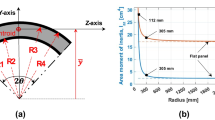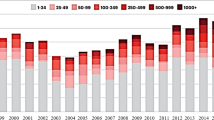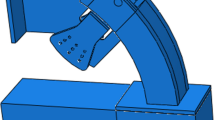Abstract
The progressive collapse of steel frame structures under the blast load was investigated using LS-DYNA. The multi-material Eulerian and Lagrangian coupling algorithm was adopted. A fluid-structure coupling finite element model was established which consists of Lagrange element for simulating steel frame structures and concrete ground, multiple ALE element for simulating air and TNT explosive material. Numerical simulations of the blast pressure wave propagation, structural dynamic responses and deformation, and progressive collapse of a five-story steel frame structure in the event of an explosion near above ground were performed. The numerical analysis showed that the Lagrangian and Eulerian coupling algorithm gave good simulations of the shock wave propagation in the mediums and blast load effects on the structure. The columns subjected to blast load may collapse by shear yielding rather than by flexural deformation. The columns and joints of steel beam to column in the front steel frame structure generated enormous plastic deformation subjected to intensive blast waves, and columns lost carrying capacity, subsequently leading to the collapse of the whole structure. The approach coupling influence between structural deformation and fluid load well simulated the progressive collapse process of structures, and provided an effective tool for analyzing the collapse mechanism of the steel frame structure under blast load.
Similar content being viewed by others
References
Breen J E. HUD-PDR-182 Research Workshop on Pro-Gressive Collapse of Building Structures: Summary Report [R]. Department of Housing and Urban Development, Washington DC,USA, 1976.
Leyendecker E V, Ellingwood B R. Design Methods for Reducing the Risk of Progressive Collapse in Buildings [M]. NBS Building Science Series 98, Washington DC, USA, 1977.
Hakuno M, Meguro K. Simulation of concrete-frame collapse due to dynamic loading [J]. J Eng Mech, 1993, 119(9):1709–1723.
Isobe D, Toi Y. Analysis of structurally discontinuous reinforced concrete building frames using the ASI technique [J]. Comput Struct, 2000, 76(4):471–481.
Westine P S, Baker W E. Energy Solutions for Predicting Deformations in Blast-Loaded Structures [R]. Technical Report to Edgewood Arsenal. Aberdeen proving ground, Md, United States, 1975.
Dobbs N. Structures to Resist the Effects of Accidental Explosions. Volume 1. Introduction [R]. Large Caliber Weapon Systems Lab. Report to Army Armament Research and Development Command. Dover, NJ, United States, 1987.
Ayvazyan H, Dede M, Dobbs N et al. Structures to resist the Effects of Accidental Explosions. Volume 2. Blast, Fragment, and Shock Loads [R]. Large Caliber Weapon Systems Lab. Report to Army Armament Research and Development Command. Dover, NJ, United States, 1986.
Dede M, Sock F, Lipvin S S et al. Structures to Resist the Effects of Accidental Explosions. Volume 3. Principles of Dynamic Analysis [R]. Large Caliber Weapon Systems Lab. Report to Army Armament Research and Development Command. Dover, NJ, United States, 1984.
Dede M, Dobbs N. Structures to Resist the Effects of Accidental Explosions. Volume 4. Reinforced Concrete Design [R]. Large Caliber Weapon Systems Lab. Report to Army Armament Research and Development Command. Dover, NJ, United States, 1987.
Kossover D, Dobbs N. Structures to Resist the Effects of Accidental Explosions. Volume 5. Structural Steel Design [R]. Large Caliber Weapon Systems Lab. Report to Army Armament Research and Development Command. Dover, NJ, United States, 1987.
Dede M, Lipvin S S, Dobbs N et al. Structures to Resist the Effects of Accidental Explosions. Volume 6. Special Considerations in Explosive Facility Design [R]. Large Caliber Weapon Systems Lab. Report to Army Armament Research and Development Command. Dover, NJ, United States, 1985.
Krauthammer T, Muralidharan R, Schmidt W. Combined symbolic numeric structural damage assessment for post-attack conditions [C]. In: Proceedings of the Second International Conference on Structures Under Shock and Impact II. Portsmouth, UK, 1992. 271–282.
Krauthammer T. Blast mitigation technologies: Developments and numerical considerations for behavior assessment and design [C]. In: Proceedings of the 1998 5th International Conference on Structures Under Shock and Impact V. Thessaloniki, Greece, 1998. 3–12.
Krauthammer T, Oh G J. Blast-resistant structural steel connections [C]. In: Proceedings of the 1998 5th International Conference on Structures Under Shock and Impact V. Thessaloniki, Greece, 1998. 63–72.
LS-DYNA Keyword User’s Manual [M]. Livermore Software Technology Corporation, Livermore, 2001.
Bassim M A, Panic N. High strain rate effects on the strain of alloy steels [J]. J Mater Process Technology, 1999, 92/93:481–485.
Ogawa K. Mechanical behaviour of metals under tension-compression loading at high strain rates [J]. Internat J Plasticity, 1985, 1:347–358.
Cowper G R, Symonds P S. Strain-Hardening and Strain-Rate Effects in the Impact Loading of Cantilever beams [R]. Report to Brown Univ. Providence RI. United States, 1957.
Wang J. Simulation of Landmine Explosion Using LS-DYNA Software [R]. Benchmark Work of Simulation of Explosion in Solid and Air. Aeronautical and Maritime Research Laboratory, 2001.
Author information
Authors and Affiliations
Corresponding author
Additional information
Supported by National Natural Science Foundation of China (No.50608026).
ZHANG Xiuhua, female, born in 1970, Dr, associate Prof.
Rights and permissions
About this article
Cite this article
Zhang, X., Duan, Z. & Zhang, C. Numerical simulation of dynamic response and collapse for steel frame structures subjected to blast load. Trans. Tianjin Univ. 14 (Suppl 1), 523–529 (2008). https://doi.org/10.1007/s12209-008-0090-y
Accepted:
Published:
Issue Date:
DOI: https://doi.org/10.1007/s12209-008-0090-y




